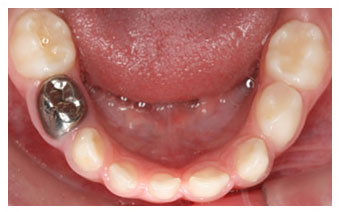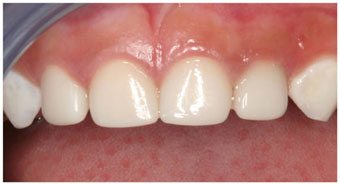Cavities are the result of tooth decay caused by plaque on the tooth surface. Cavities in baby teeth spread quickly because the enamel is thinner than adult teeth. Prompt treatment is needed to prevent the cavity from getting deeper and reaching the nerve of the tooth, causing pain/infection. Small to mid-sized cavities can be repaired with fillings. Here at ToothStars, we offer two options for filling materials: composite resin (white), which mimics the shade of the natural tooth or amalgam (silver).
Dr. Reena will discuss which material she feels best suits the needs of the patient and will be happy to talk to you regarding your treatment options and preferences.
Bonding is a conservative way to repair slightly chipped, discolored, or cracked teeth. During dental bonding, a white filling is placed onto your child’s tooth to improve its appearance, form, and function. The filling “bonds” with the tooth. It comes in a variety of tooth-colored shades, so we are able to closely match the appearance of your child’s natural teeth. This is a very good treatment option in the child’s 'growing' phase because anything more permanent (crown/vaneer) would have to wait till the child has transitioned into adulthood. Bondings can stain and are easier to break than porcelain. However, if it does break or chip, tell your doctor. The bonding can generally be easily patched or repaired in one visit.
When a tooth is cracked or has a deep cavity, bacteria can enter the pulp (nerve) tissue and can cause an infection inside the tooth. If left untreated, an abscess may form causing swelling and pain. The pain may subside temporarily with pain medication and antibiotics but will return if not treated. An untreated infection can cause damage to the developing adult tooth underneath or, if severe, can get into the bloodstream which will require your child to go to the hospital for emergency care.
During treatment, Dr. Reena will remove the infected pulp tissue in the crown of the tooth for a pulpotomy or into the root(s) for a pulpectomy. The interior of the tooth will be cleaned and sealed. A medicine will be placed to calm the nerve and prevent further bacterial growth. A crown will then be placed to protect the tooth from breaking down. With good homecare (regular brushing and flossing) and regular check-ups, the tooth can last until it is ready to be lost by the permanent tooth. It is our goal to preserve the baby teeth as long as possible so that the permanent teeth come in the correct place.
Crowns are a restorative procedure for teeth that have extensive decay or damage that cannot be repaired with a filling and are often the treatment of choice for young children with extensive decay. It can stabilize further breakdown and restore the form and function of the tooth. If the cavity is close approaching the nerve of the tooth, often a nerve treatment will be performed (see pulpotomy) and then a crown will be placed. A crown is a very robust treatment option which can save a tooth from being extracted, if cared for appropriately. A crown covers the entire surface of the tooth to give it strength and provide function until the permanent adult tooth comes in. There are two primary types of crowns for children that are offered here at ToothStars:


There are times when it is necessary to remove a tooth. Dental extractions are sometimes necessary if a child’s tooth has been severely damaged from trauma, dental decay, infected, or for orthodontic purposes. Here at ToothStars, we value baby teeth and always try to preserve them whenever possible. If your child requires a dental extraction, don’t worry, we are trained to make them feel as comfortable as possible and we will help them through the appointment so that they feel at ease!
Teeth like to touch together and if a child loses a baby tooth, due to extraction or trauma, the adjacent teeth in the area start to drift or tilt towards the new space. If shifting occurs, it will lead to loss of space for the new adult tooth to come into. Therefore, a space maintainer (a metal appliance that is custom made to hold the space) is used to try to keep any shifting from occurring.
Mouthguards are required in only four school-based sports: football, ice hockey, lacrosse, and field hockey. Yet basketball and baseball are associated with the largest number of dental injuries. Other sports for which the American Dental Association (ADA) recommends wearing a mouthguard include bicycling, soccer, skateboarding, wrestling and volleyball. Do mouthguards work? The ADA estimates that athletes who don't wear mouthguards are 60 times more likely to suffer dental injury than those who wear them. Protecting your child's smile while playing sports is essential. Mouthguards help protect the teeth and gums from injury.
Choosing the right mouthguard is essential. There are three basic types of mouthguards: the pre-made mouthguard, the “boil-and-bite” fitted mouthguard (which can be purchased at your local pharmacy) and a custom-made mouthguard from the dentist. When you choose a mouthguard, be sure to pick one that is tear-resistant, comfortable, well-fitted for your child's mouth, easy to keep clean, and does not prevent your child from breathing properly. At the present time, when top-quality sports equipment for kids can run in the hundreds of dollars, it makes more sense than ever to invest in the proven protection of a professionally made, custom-fitted mouthguard. If it is comfortable to wear, your child is more likely to use it. Just ask us about it! Dr. Reena will be happy to discuss the different options with you and to recommend which one would be best suited for your child.
If your child often wakes up with jaw pain, earaches, headaches, or you see your child clenching or grinding their teeth, then your child may have a common condition called "bruxism". Many people do not even know they grind their teeth, because it often occurs during sleep. But, many parents report that they hear their child grinding at night. Bruxism can lead to broken teeth, cracked teeth, or even tooth loss in severe cases. For younger children with baby teeth, grinding is very common. Hence, nightguards are not recommended for this age group. However, when your child has lost all of their baby teeth and has all of their adult teeth present, nightguards can be made.
Nightguards are an easy, non-invasive treatment for bruxism and are typically worn at night. Nightguards prevent the wear and damage that is caused by teeth-grinding over time. A custom-made night guard made from soft material is inserted more commonly over your child’s top teeth or over bottom teeth and prevents contact with opposing teeth. It takes 2 visits to make a custom fitted night guard. During the first visit, we take a mold of your child’s teeth. The mold is then sent to a laboratory to make the custom fitted night guard. During the second visit, the night guard is applied to your child’s mouth to ensure proper fitting. Dr. Reena will be happy to answer any further questions that you may have.